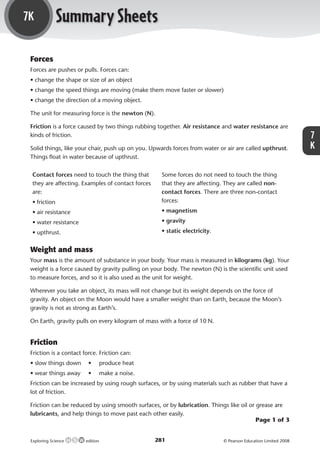Weitere ähnliche Inhalte
Mehr von themassmaker (20)
Forces
- 1. 7K Summary Sheets
Forces
Forces are pushes or pulls. Forces can:
• change the shape or size of an object
• change the speed things are moving (make them move faster or slower)
• change the direction of a moving object.
The unit for measuring force is the newton (N).
Friction is a force caused by two things rubbing together. Air resistance and water resistance are
kinds of friction. 7
Solid things, like your chair, push up on you. Upwards forces from water or air are called upthrust. K
Things float in water because of upthrust.
Contact forces need to touch the thing that Some forces do not need to touch the thing
they are affecting. Examples of contact forces that they are affecting. They are called non-
are: contact forces. There are three non-contact
• friction forces:
• air resistance • magnetism
• water resistance • gravity
• upthrust. • static electricity.
Weight and mass
Your mass is the amount of substance in your body. Your mass is measured in kilograms (kg). Your
weight is a force caused by gravity pulling on your body. The newton (N) is the scientific unit used
to measure forces, and so it is also used as the unit for weight.
Wherever you take an object, its mass will not change but its weight depends on the force of
gravity. An object on the Moon would have a smaller weight than on Earth, because the Moon’s
gravity is not as strong as Earth’s.
On Earth, gravity pulls on every kilogram of mass with a force of 10 N.
Friction
Friction is a contact force. Friction can:
• slow things down • produce heat
• wear things away • make a noise.
Friction can be increased by using rough surfaces, or by using materials such as rubber that have a
lot of friction.
Friction can be reduced by using smooth surfaces, or by lubrication. Things like oil or grease are
lubricants, and help things to move past each other easily.
Page 1 of 3
Exploring Science edition 281 © Pearson Education Limited 2008
M11_ES_AB_Y7_2445_U7K.indd 281 3/3/08 16:30:17
- 2. 7K Summary Sheets (continued)
Density and floating
You can decide if something will float by working out its density. Density is the mass of a certain
volume of something, and it can be calculated using this formula:
mass
density =
volume
The units for density are g/cm3.
The density of water is 1 g/cm3. If an object has a density less than 1 g/cm3, it will float. If its
7 density is greater, it will sink.
K
Balanced forces
Balanced forces are forces that cancel each other out. Balanced forces do not change the speed
that something is moving.
Upthrust
The forces on the balloon are
balanced. The balloon will not
move.
weight
Page 2 of 3
Exploring Science edition 282 © Pearson Education Limited 2008
M11_ES_AB_Y7_2445_U7K.indd 282 3/3/08 16:30:18
- 3. 7K Summary Sheets (continued)
Measuring forces N 0
Elastic materials will stretch with a force and then return to 1
their original shape when the force is taken away. Materials like 2
This force meter
Plasticine will stretch with a force but they will not return to their 3
is measuring a
4
original shape afterwards. Plasticine is not elastic. force of 1 N
5
Springs are used to measure the size of a force because they are
elastic. A big force stretches a spring further than a small force.
Force meters have springs inside them.
7
Speed K
To measure how fast something is travelling, you need to measure
the distance it travels and the time taken. Units for speed are km/h or m/s or mph. The unit for
speed depends on the units you have used to measure the distance and the time.
Stopping distances
A moving car takes some time to stop. The distance it travels while the driver is deciding to stop
is called the thinking distance, and the distance it travels while it is slowing down is called the
braking distance. If you add the two distances together you get the stopping distance.
Stopping distances are longer if the road is wet or icy, if the car has worn tyres or if the driver is
tired or has been drinking alcohol. Stopping distances are also longer if the car is travelling faster.
Distance–time graphs
A journey can be shown on a distance–time graph. This graph shows a person running,
then stopping for a rest, then walking slowly. The steeper the line on the graph, the faster they
are moving.
3
2
Distance (km)
1
0
0 10 20 30 40
Time (minutes)
Page 3 of 3
Exploring Science edition 283 © Pearson Education Limited 2008
M11_ES_AB_Y7_2445_U7K.indd 283 3/3/08 16:30:19
